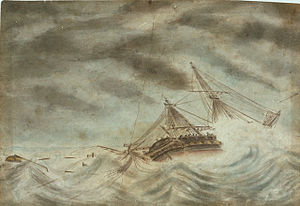
HMS Agincourt was a 64-gun third-rate ship of the line of the Royal Navy, launched on 23 July 1796 at Blackwall Yard, London. The Admiralty bought her on the stocks from the East India Company in 1796, who had called her Earl Talbot.

HMS La Hogue was a 74-gun third-rate ship of the line of the Royal Navy, launched on 3 October 1811 at Deptford. She was named after the 1692 Battle of La Hogue. "The La Hogue of 1811 [...] sported a green and chocolate lion, its grinning mouth displaying rows of white teeth and a huge red tongue."

HMS Pegasus was a 28-gun Enterprise-class sixth rate. This frigate was launched in 1779 at Deptford and sold in 1816. Pegasus had a relatively uneventful career and is perhaps best known for the fact that her captain from 1786 to 1789 was Prince William Henry, the future King William IV. By 1811 Pegasus was a receiving ship at Chatham; she was sold in 1816.

HMS Thetis was a 38-gun fifth-rate frigate of the Royal Navy launched in 1782.

HMS Northumberland was a 74-gun third-rate ship of the line of the Royal Navy, built at the yards of Barnard, Deptford and launched on 2 February 1798. She carried Napoleon to his final exile on St Helena.

HMS Hector was a 74-gun third rate ship of the line of the Royal Navy, launched on 27 May 1774 at Deptford.

HMS Diadem was a 64-gun third rate ship of the line of the Royal Navy, launched on 19 December 1782 at Chatham. She participated in the Battle of Cape St Vincent in 1797 under Captain George Henry Towry.

HMS Dragon was a 74-gun third rate ship of the line of the Royal Navy, launched on 2 April 1798 at Rotherhithe. She was designed by Sir William Rule, and was the only ship built to her draught.
HMS Chichester was a 70-gun third rate ship of the line of the Royal Navy, built by Peirson Lock at Portsmouth Dockyard to the standard draught for 70-gun ships as specified in the 1745 Establishment amended in 1750, and launched on 4 June 1753.

HMS Hind was a 28-gun sixth-rate frigate of the Royal Navy.

HMS Dido was one of the twenty-seven Enterprise class of 28-gun sixth-rate frigates in service with the Royal Navy during the late eighteenth and early nineteenth centuries. Dido was commissioned in September 1787 under the command of Captain Charles Sandys. She participated in a notable action for which her crew would later be awarded the Naval General Service Medal; her participation in a campaign resulted in the award of another. Dido was sold for breaking up in 1817.
HMS Winchelsea was a 32-gun fifth-rate Niger-class frigate of the Royal Navy, and was the sixth Royal Navy ship to bear this name. She was ordered during the Seven Years' War, but completed too late for that conflict. She cost £11,515-18-0d to build.

HMS Alligator was a 28-gun Enterprise-class sixth rate frigate of the Royal Navy. She was originally ordered during the American War of Independence but was completed too late to see service during the conflict. Instead she had an active career during the French Revolutionary and Napoleonic Wars.

HMS Santa Dorothea was a Royal Navy 34-gun fifth rate. This frigate had previously served in the Spanish Navy under the name Santa Dorotea. Built in Spain in 1775, she served during the early years of the French Revolutionary Wars until being captured while sailing as part of a squadron off Cartagena. Taken into British service, she spent the rest of the French Revolutionary and most of the Napoleonic Wars under the white ensign, until being broken up in 1814.
The French brig Alerte was launched in April 1787. The Royal Navy captured her at Toulon in August 1793, and renamed her HMS Vigilante. The British set her on fire when they evacuated Toulon in December of that year. After the French rebuilt her as Alerte, she served at the Battle of Aboukir Bay. The British recaptured her in June 1799 and took her into service as HMS Minorca. Minorca was sold in 1802.
HMS Resource was a 28-gun Enterprise-class sixth-rate frigate of the Royal Navy. She was launched in 1778 and sold for breaking up in 1816.

HMS Cyclops was a 28-gun Enterprise-class sixth-rate frigate of the Royal Navy. The Cyclops was first commissioned in July 1779 under the command of Captain John Robinson.
HMS Vestal was a 28-gun Enterprise-class sixth-rate frigate of the Royal Navy.

HMS Pomona was a 28-gun Enterprise-class sixth-rate frigate of the Royal Navy. Pomona was first commissioned in September 1778 under the command of Captain William Waldegrave.

HMS Venus was the name ship of the 36-gun Venus-class fifth-rate frigates of the Royal Navy. She was launched in 1758 and served for more than half a century until 1809. She was reduced from 36 to 32 guns in 1792. She was sold in 1822.
















